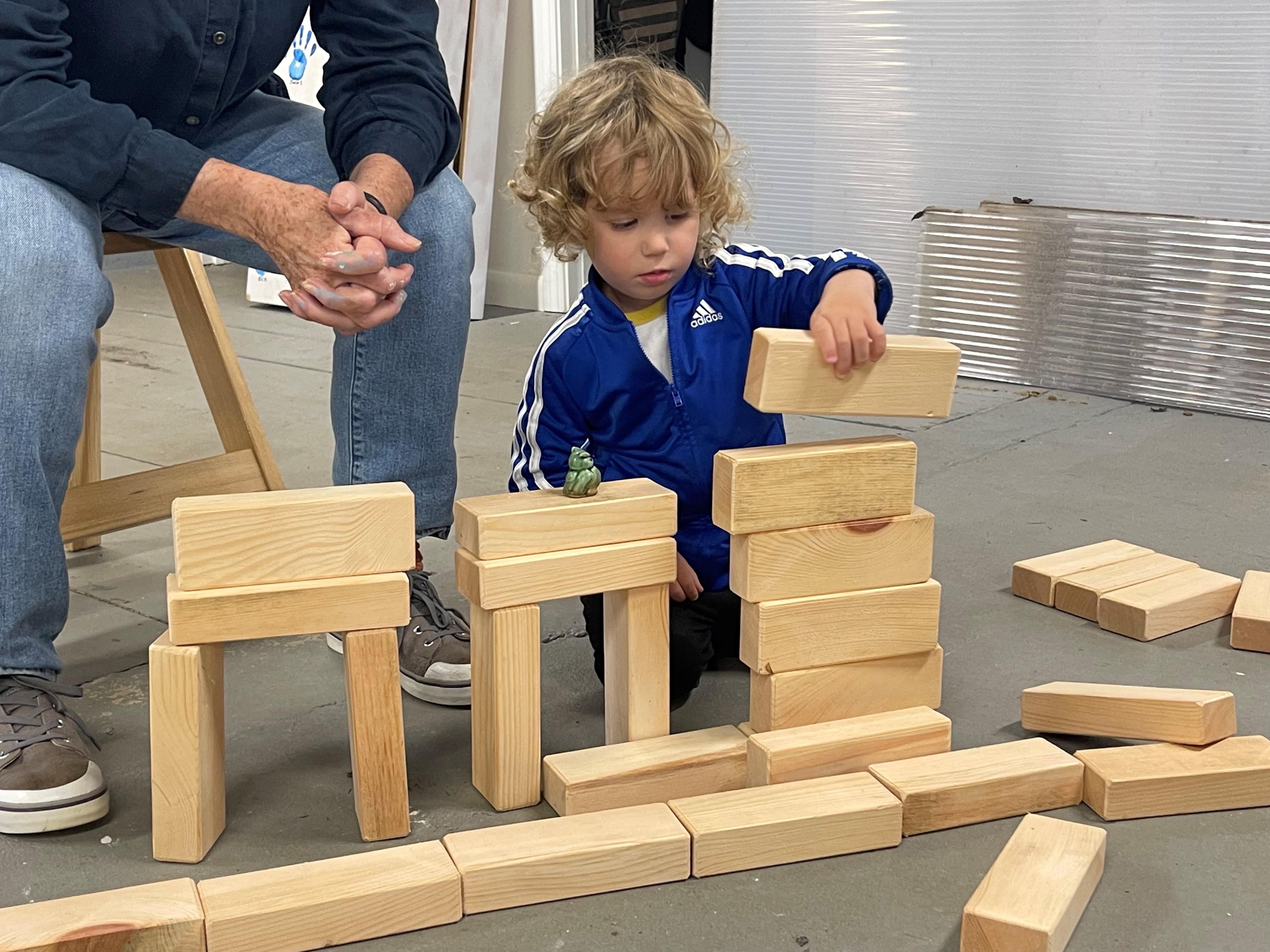Yet another way trees help us to grow
- Tags:
- Working Forests

A young friend is building skills and memories while playing with these blocks made from a Little Harbor Road White Pine tree.
When the Forest Society's Education Center at Creek Farm was gifted a few Eastern White Pine trees from Eversource after they needed to be removed from Little Harbor Road last year, I knew we had a plethora of ways that the wood could be put to good use in the community. We use products made from trees every day, such as wood and paper in addition to many products you would never guess came from a tree. Wood byproducts and chemicals extracted from trees are used to make thousands of products. Forest product companies are an extremely efficient industry. All parts of the log are used, so there is virtually no waste, and leftover sawdust is used for energy to run the mills.
There are so many examples of products made from wood: houses, furniture, toothpicks, baseball bats, musical instruments, handles, charcoal, toys, crutches, fences, airplane parts, floors, boats, bridges, cabinets, canes, boxes, coffins, barrels, decks, docks, doors, matches, canoe paddles, poles, pencils, picture frames, Popsicle sticks, railroads, roller coasters, spoons, kegs, dams, athletic equipment, clothespins, ladders and spools.
Wood pulp is used to make all paper products, including books, paper bags, notebooks, packaging material, calendars, cardboard boxes, coffee filters, egg cartons, envelopes, tissues, toilet paper, magazines, newspapers, paper towels, cards and wallpaper. Blankets, building insulation, diapers and sanitary pads, and leather tanning agents also are made with wood pulp. And the list goes on and on and on.
With our small milling job of around eight trees, we have created numerous activities and products benefiting Creek Farm. We had milling workshops where folks could come and see the mill in action and with the support of the Fuller Foundation, we were able to put on very successful bat house and bird house building workshops, creating habitat.
In addition we teamed up with Urban Forestry Center and built Owl Boxes, Leopold Benches and Stump Benches, Story Stroll holders, siding and planting boxes to be used with our partnership with the Monarch School of New England.
Our local community took advantage of the "free" pile of wood that was available, many making coffee tables and other objects for their home, and we asked our talented volunteer woodworker, Steve Neuhoff to turn some of that wood into giant lawn dice and a giant Jenga game.
Steve has been a land steward with us since 2016 and helps out at additional workdays, but really is a carpenter at heart. One of our younger visitors at a recent program showed us that the blocks were a big hit - spending hours building a train, building towers and bridges and knocking them over, and more. Yet another way that our beloved trees give back to us and help US to grow as well!
The benefits of block play are enormous, and engage a ton of skills. When they play with blocks, children get a chance to problem-solve, troubleshoot, and test hypotheses about structure, gravity, and elevation. Here are just some of the ways that block play helps children to grow!
- Problem solving. Sometimes it is intentional: “I want to build X. How do I do that?” Other times it is in-themoment: “To go higher and add to one side, what can I use?”
- Imagination. Children can follow their own plan, or they can share a friend’s vision and work together to create something they never dreamed of.
- Self-expression. Blocks offer many ways for young dual language learners to explore, express themselves, and demonstrate what they are learning across languages.
- Mathematics. Important concepts and skills are practiced and strengthened through block play, including length, measurement, comparison, number, estimation, symmetry, balance.
- Continuity and permanence. Block play engages spatial sense and motor abilities; it can be a solo or a group effort; block creations can stand for an indefinite period of time.
- Creativity. Blocks and other loose parts can be moved freely by children, to be combined and recombined in countless ways.
- Science. Blocks offer opportunities to test hypotheses and build scientific reasoning.
- Self-esteem. Children discover that they have ideas and that they can bring their ideas to life by creating, transforming, demolishing, and re-creating something unique.
- Social and emotional growth. Blocks help children learn to take turns and share materials, develop new friendships, become self-reliant, increase attention span, cooperate with others, and develop self-esteem.
Blocks help development in all areas and we are very excited to have the next step of educating those that use the blocks as to where they came from, building that relationship with our natural world. As an organization that truly loves trees and works tirelessly to protect and steward our forests, it is always amazing to witness all that trees give to us, while asking nothing in return. Watching a child play with blocks made from local trees that had to be cut down, knowing that those trees continue to be such an important part of our community, that's the good stuff!
Would you like to learn more about the importance of block play for children? Check out this great article - https://parentingscience.com/toy-blocks/
